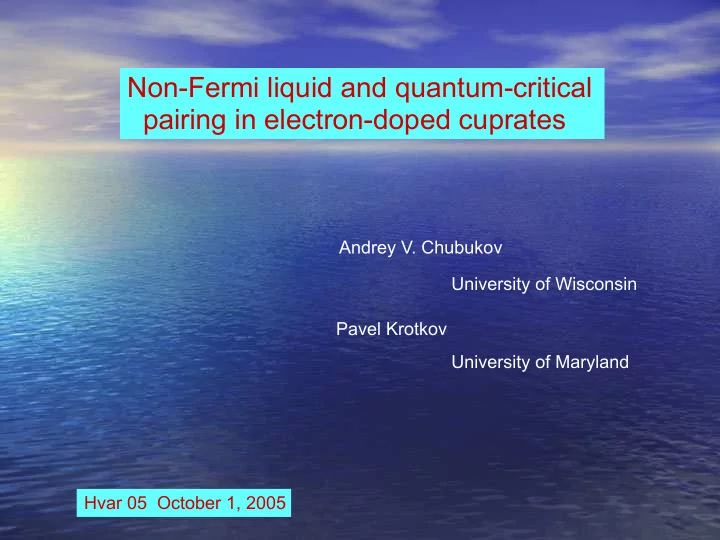

Non-Fermi liquid and quantum-critical pairing in electron-doped cuprates Andrey V. Chubukov University of Wisconsin Pavel Krotkov University of Maryland Hvar 05 October 1, 2005
Motivation Is there a niche for itinerant models in the cuprates? Itinerant = fermions + low-energy collective modes (no Mott physics) hole doped electron doped
Electron-doped cuprates Nd 2-x Ce x CuO 4 SDW Tc Pr 2-x Ce x CuO 4 Zimmers et al Steglish et al, Von Lohneysen et al, ….. Mathur et al, similar in Ce 2 XIn 5 , Pagliuso et al
Sketch of experimental data 1. Antiferromagnetic state hole-doped electron-doped Hot spots are closer to zone diagonals than in hole-doped cuprates AFM state = SDW state T. Sato et al Armitage et al, Damascelli et al
2. Mott physics Opt doping, x ~0.15 SDW gap, x ~0.1 Mott gap, x=0 Onose et al, Mott physics seems to nearly disappear around Zimmers et al optimal electron doping
3. Superconducting state 3.1 D-wave (most likely), Δ scales with Tc ARPES Rama n Blumberg et al
3. Superconducting state 3.2 Non-monotonic d-wave gap ARPES Rama n T.Sato et al Blumberg et al
At what geometry of the Fermi surface antiferromagnetism ends? RPA calculation t-t’ model Antiferromagnetism ends when hot QCP2 spots merge along zone diagonals Onufrieva, Pfety, Eremin, Zlatic
The model Near-diagonal fermions, interacting via the exchane of antiferromagnetic spin fluctuations • � low-energy fermions • � collective mode in the spin channel • � spin-fermion interaction (analog of U) Scalapino, Prelovsek, Zlatic, … Di Castro et al (spin-> charge) coupling g Two input parameters:
System properties at QCP 1. Normal state: • Fermi-liquid is broken for diagonal fermions: • There is only one energy scale at QCP Almost MFL QC behavior Fermionic self- energy “High frequency”, but still QC behavior Dynamic spin susceptibility
numerics N=2
Optical conductivity ω > ω 0 are relevant Re and Im parts of Conductivity should generaly have different functional forms
Optical conductivity Results:
Pr 1.85 Ce 0.15 CuO 4 C. Homes et al Similar results for Bi2212 van der Marel et al
B 2G Raman scattering Experiment finite T part T=0 part Blumberg et al
B 2G Raman scattering Theor y B 2G Raman vertex Doesn’t change sign when k -> k + π , and approximately satisfies Ward identity
2. Superconductivity + hole-doped electron-doped What happens with Tc when hot spots merge along zone diagonal? Is d-wave gone? A transition to s-wave? Yakovenko et al
interaction is larger than Yakovenko et al Still, attraction in a d-wave channel No other Small Small smallness In the normal state, there was only one scale coupling g Parameters: For the pairing problem:
Results: 1. Onset temperature of the pairing numerics analytics flat region Abanov, AC, Finkelstein Tc ~ 0.0005 g, weakly depends on r Same parameters as in hole-doped materials: Prelovsek et al, Norman et al r ~ 0.08, Tc ~ 10K
r ~ 0.08 Tc ~ 10K
Some analytics/reasons for flattening Small r numerics
g = 1.7 eV Tc (K) r Tc (K) small small r r Tc =0.5 g r actual Tc Actual Tc r r
2. Momentum dependence of the gap Gap Frequency Momentum p y Pairing gap is non-monotonic even when hot spots are out
2. Momentum dependence of the gap Pairing gap is non-monotonic even when hot spots are out
Conclusions Problem: fermions near zone diagonals, interacting with collective AFM spin fluctuations • non-FL in the normal state “scaling” behavior of the conductivity flat B 2G Raman intensity • d-wave pairing by spin fluctuations Tc ~10K (for the same coupling as for hole-doped) gap is highly non-monotonic Unsolved problems: • self-energy and the pairing in SDW phase • how Mott physics emerges at x->0
THANK YOU
Recommend
More recommend